Sweden’s “Dry Tinder” Accounts for Many Covid-19-deaths

Compared to other countries, Sweden had a soft mandatory lockdown. Sweden also experienced a high death toll compared to other Nordic countries. By mid-September 2020 and adjusting for population, Sweden had 5.3 times as many Covid-19-deaths as Denmark, 9.5 times as many as Finland, and 11.8 times as many as Norway.
The high death toll has been attributed to the soft lockdown, but Sweden had a remarkably mild flu season in 2018/19 and 2019/20. Many vulnerable souls who normally would have died of the flu survived to April 2020 and, then, sadly died from Covid-19 instead. This buildup of a stock of vulnerable persons has been called “dry tinder.” The “tinder” metaphor is that more forest fires this year can be explained by fewer fires in previous years. Dry tinder accumulated, awaiting a spark.
A recent article suggests that dry tinder in Sweden is an important factor in explaining the country’s large number of Covid-19 deaths. Sweden was an exceptional case, both compared to other Nordic countries and in a historical perspective. Dry tinder is important for our understanding of the differences in Covid-19 deaths tolls between countries.
‘Dry tinder’ in the Nordic countries
I calculate the change in the stock of “dry tinder” in a given month as the difference between the expected death toll and the actual death toll for that month. The expected death toll for January 2015 is estimated as the average of death tolls from January 2012 to December 2014 plus February 2015 to January 2018. The expected death toll is estimated based on an average of actual death tolls 3 years prior and 3 years after the given month. The stock of “dry tinder” is approximated by the sum of all changes in the stock the previous 24 months.
The figure below—with Sweden in yellow—shows the stock of “dry tinder” in the Nordic countries from primo January 2005 to primo April 2020. The figure shows that the stock of “dry tinder” was unusually high in Sweden going into the Covid-19 pandemic, whereas the stock in other Nordic countries was within normal ranges.
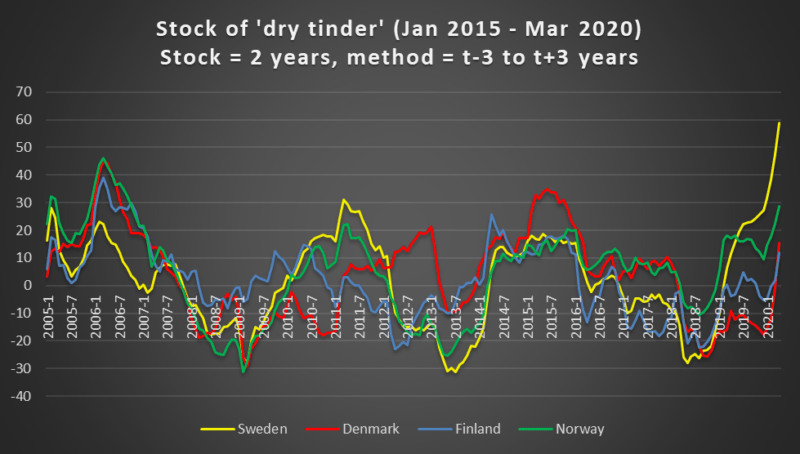
Source: Statistiska Centralbyrån, Danmarks Statistik, Statistisk Sentralbyrå, Tilastokeskus
The situation of April 2020 in Sweden stands out in a longer perspective. The figure below illustrates that the stock of dry tinder in Sweden was unusually high going into the Covid-19 pandemic even in a historical perspective. Not since the beginning of the 1970s has the stock in Sweden been as high as it was around April 2020.
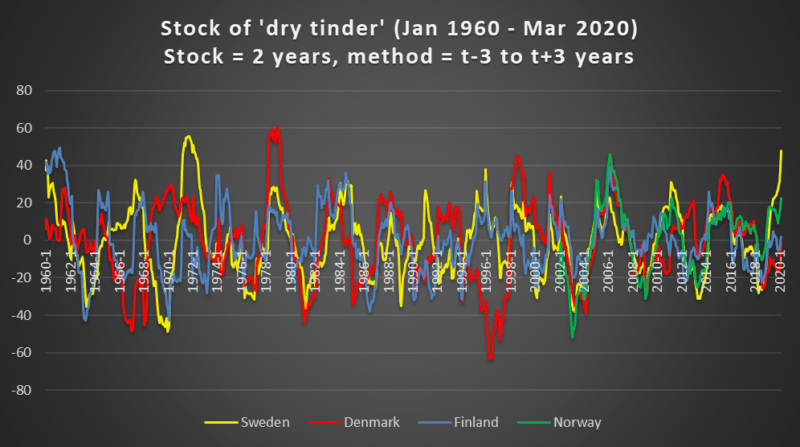
Source: Statistiska Centralbyrån, Danmarks Statistik, Statistisk Sentralbyrå, Tilastokeskus
Correlation between stock of “dry tinder” and excess mortality
The figure below shows the correlation between the change in excess mortality in one season (November to April) and excess mortality the year before. The figure shows that an increase in excess mortality in one year is usually followed by a decrease in excess mortality the following year. The correlation is remarkably strong and highly significant for all countries (except for Norway, where there are only 19 observations) and gives us a clear indication of the truthfulness of the thesis that the stock of “dry tinder” is an important part of explaining excess mortality in a given year.
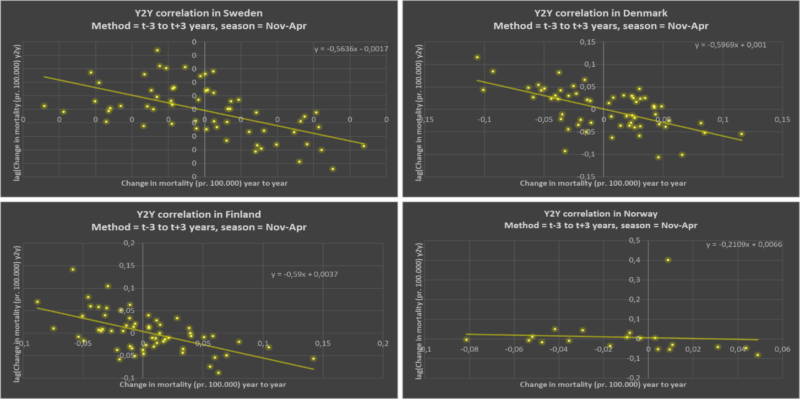
Source: Statistiska Centralbyrån, Danmarks Statistik, Statistisk Sentralbyrå, Tilastokeskus
I also measure the stock of “dry tinder” and its relationship to excess mortality. The relationship is displayed in the figure below. The figure shows that there is a positive correlation between the stock of “dry tinder” primo season each year (x-axis) and the excess mortality for the coming flu season (y-axis), although the correlation in this simple specification is statistically significant only for Finland (at the 0.03 level).
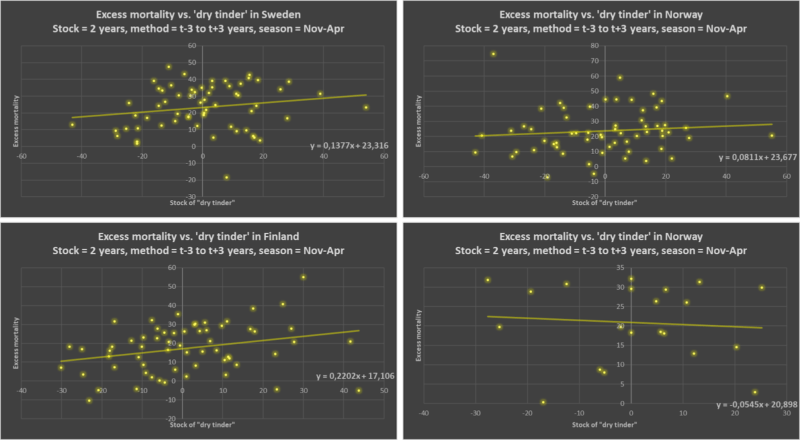
Source: Statistiska Centralbyrån, Danmarks Statistik, Statistisk Sentralbyrå, Tilastokeskus.
Sweden’s stock of “dry tinder” was as large as the number of Covid-19-deaths in Sweden
The figure below shows the stock of “dry tinder” primo April and confirmed Covid-19-deaths in the Nordic countries. The relationship is striking, being almost one to one for Sweden, Denmark and Finland. Only Norway stands out as a country, where the stock of “dry tinder” was significantly larger than the Covid-19 death toll.
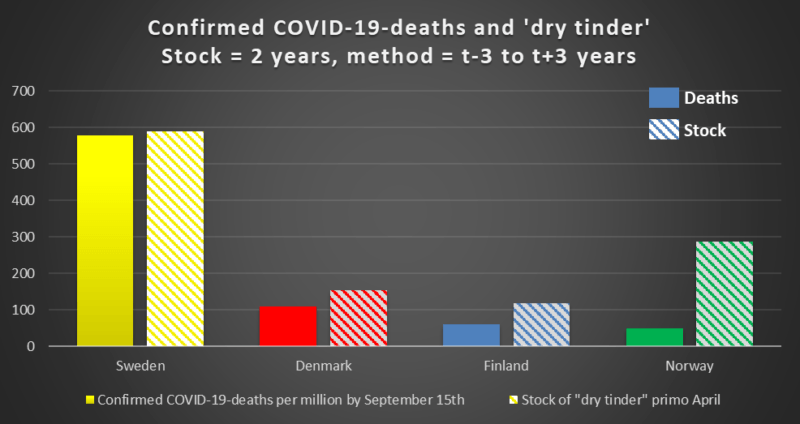
Source: Statistiska Centralbyrån, Danmarks Statistik, Statistisk Sentralbyrå, Tilastokeskus.
The figure illustrates that differences in the stock of “dry tinder” appears to explain some (or even much) of the differences in mortality and explicitly the high Covid-19-death toll in Sweden.
Was the lack of lockdowns to blame for the high death toll in Sweden?
There is no doubt that Sweden experienced very few deaths between January 2019 and March 2020. That was unique to Sweden in a Nordic setting: Denmark and Finland did not have large stocks of “dry tinder” primo April 2020 with Norway as a potential middle case.
“Dry tinder” does not catch fire if there is no spark, and the presence of Covid-19 at Swedish nursing homes was exactly that spark, killing thousands who potentially could have lived on for several months.
An open question is why Sweden had an unusually high number of vulnerable people heading into the Covid-19-pandemic. Sweden had an uncommonly mild flu season in Sweden in 18/19 and 19/20. Also, the mortality in Sweden was remarkably low during the summer 2019 (see Figure 5 here). Why Sweden had such mild flu seasons compared to its neighbors is unclear, but the facts are the facts.
Lately, people have been criticizing Sweden’s health and elder care, but the failures of the Covid-19 period are in large part a reflection of the successes during the runup. Swedes did a great job in the two-year runup to March 2020 and were then punished by Covid-19.
The data are clear: In understanding Covid-19-death tolls, “dry tinder” is a major factor.












